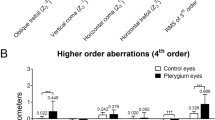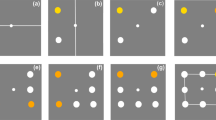Abstract
Aim To investigate the effects of fibrovascular traction and the pooling of tears at the pterygium apex on the corneal topographic changes induced by pterygium.
Methods A total of 16 eyes of 14 cases with primary pterygium were included in the study. A computerized corneal topography system was used for corneal topography examinations. Baseline keratographs were taken two times at straight gaze. A repeat corneoscope photograph was immediately obtained in temporal gaze. Then the tears at the pterygium apex were dried with a cellulose sponge, and a new corneoscope photograph was immediately obtained without allowing one to blink. Corneal topographic maps (numeric maps) were divided into 301 fields in 24 meridians. One colour was allocated to each field, representing its mean refractive power for all groups. In all eyes, keratometric astigmatism at the 3 mm central cornea and total mean corneal refractive power were found. Data were compared using paired-samples two-tailed t-tests.
Results Keratometric astigmatism at the 3 mm central cornea was significantly reduced at the temporal gaze (3.10±2.34 D, t=3.40, P=0.027) and dried eyes (2.12±1.01 D, t=4.74, P=0.001) according to the first baseline measurement (4.31±1.91 D) of the total mean corneal refractive power was found to be 43.45±1.28 D (39.29–45.87) at the first baseline measurement. There was no change at the temporal gaze (43.54±1.06 D, P>0.05). However, the total corneal refractive power was significantly higher in dried eyes (44.26±0.93 D, t=34.92, P<0.001). The steepest region of corneal topography was a superior quadrant, and the flattest area was a nasal quadrant at the baseline. At the temporal gaze, the cornea was significantly flatter in the superior and inferior sides of the pterygium meridian. After dried pooling of tears, topographic abnormalities returned, and the cornea became more uniform and symmetric.
Conclusion We conclude that the pooling of tears at the pterygium apex plays an important role, but fibrovascular traction has no effect on the corneal topographical changes induced by pterygium.
Similar content being viewed by others
Log in or create a free account to read this content
Gain free access to this article, as well as selected content from this journal and more on nature.com
or
References
Coroneo MT . Pterygium as an indicator of ultraviolet insulation: a hypothesis. Br J Ophthalmol 1993; 77: 734–739.
Reinstrow SD . The conjunctiva. In: Chandler JW, Sugar J, Edelhauser HF (eds). External Diseases: Cornea, Conjunctiva, Sclera, Eyelids, Lachrymal System. Textbook of Ophthalmology. Mosby-Wolfe: London, 1995, pp 2.10–2.11.
Budak K, Khater TT, Friedman NJ, Koch DD . Corneal topographic changes induced by excision of perilimbal lesions. Ophthal Surg Lasers 1999; 30: 458–464.
Wilhelmus KR . External Disease and Cornea, Baseline and Clinical Course, Section 8. American Academy of Ophthalmology: San Francisco, CA, 1999–2000; pp 339–344.
Gans L . Surgical treatment of pterygium. In: Belin MW (ed). Focal Points. Clinical Modules for Ophthalmologists, Vol. 14. American Academy of Ophthalmology: San Francisco, CA, 1996, p 12.
Oldenburg JB, Garbus J, McDonnell JM, McDonnell PJ . Conjunctival pterygia. Mechanism of corneal topographic changes. Cornea 1990; 9: 200–204.
Cameron ME . Histology of pterygium: an electron microscopic study. Br J Ophthalmol 1983; 90: 36–108.
Pavilack MA, Halpern BE . Corneal topographic changes induced by pterygia. J Refract Surg 1995; 11: 92–95.
Pavilack MA, Halpern BE . Corneal topographic changes induced by pterygia. Invest Ophthalmol Vis Sci 1993; 34: 1219.
Lin A, Stern G . Correlation between pterygium size and induced corneal astigmatism. Cornea 1998; 17: 28–30.
Hansen A, Norn M . Astigmatism and surface phenomena in pterygium. Acta Ophthalmol 1980; 58: 174–181.
Stern GA, Lin A . Effect of pterygium excision on induced corneal topographic abnormalities. Cornea 1998; 17: 23–27.
Soriano JM, Jancnecht P, Witschel H . Effect of pterygium operation on preoperative astigmatism: prospective study. Ophthalmologe 1993; 90: 688–690.
Tomidokoro A, Oshika T, Amano S, Eguchi K, Eguchi S . Quantitative analysis of regular and irregular astigmatism induced by pterygium. Cornea 1999; 18: 412–415.
Gridley MJ, Perlman EM . A form of variable astigmatism induced by pseudopterygium. Ophthal Surg Lasers 1986; 17: 794–795.
Walland MJ, Stevens JD, Steele AD . The effect of recurrent pterygium on corneal topography. Cornea 1994; 13: 463–464.
Cinal A, Yasar T, Demirok A, Topuz H . Effect of pterygium surgery on corneal topography. Ophthal Surg Lasers 2001; 32: 35–40.
Author information
Authors and Affiliations
Corresponding author
Additional information
This study has been presented at the XIVth Congress of the European Society of Ophthalmology, Istanbul
Rights and permissions
About this article
Cite this article
Yasar, T., Ozdemir, M., Cinal, A. et al. Effects of fibrovascular traction and pooling of tears on corneal topographic changes induced by pterygium. Eye 17, 492–496 (2003). https://doi.org/10.1038/sj.eye.6700377
Received:
Accepted:
Published:
Issue date:
DOI: https://doi.org/10.1038/sj.eye.6700377
Keywords
This article is cited by
-
Effect of pterygium on corneal astigmatism, irregularity and higher-order aberrations: a comparative study with normal fellow eyes
Scientific Reports (2023)
-
The effect of pterygium surgery on intraocular lens power and ocular biometric parameters
Irish Journal of Medical Science (1971 -) (2022)
-
Corneal tomography and biomechanics in primary pterygium
International Ophthalmology (2018)
-
Effects of pterygium surgery on front and back corneal surfaces and anterior segment parameters
International Ophthalmology (2012)
-
Tear function and goblet cell density after pterygium excision
Eye (2007)



